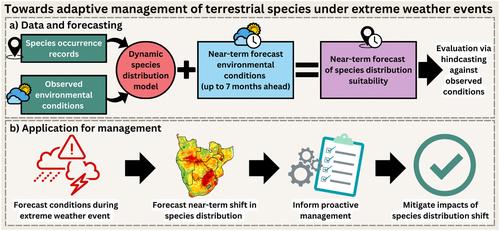当前位置:
X-MOL 学术
›
Glob. Change Biol.
›
论文详情
Our official English website, www.x-mol.net, welcomes your
feedback! (Note: you will need to create a separate account there.)
Near‐Term Forecasting of Terrestrial Mobile Species Distributions for Adaptive Management Under Extreme Weather Events
Global Change Biology ( IF 10.8 ) Pub Date : 2024-11-16 , DOI: 10.1111/gcb.17579
Rachel Dobson, Stephen G. Willis, Stewart Jennings, Robert A. Cheke, Andrew J. Challinor, Martin Dallimer
Global Change Biology ( IF 10.8 ) Pub Date : 2024-11-16 , DOI: 10.1111/gcb.17579
Rachel Dobson, Stephen G. Willis, Stewart Jennings, Robert A. Cheke, Andrew J. Challinor, Martin Dallimer

|
Across the globe, mobile species are key components of ecosystems. Migratory birds and nomadic antelope can have considerable conservation, economic or societal value, while irruptive insects can be major pests and threaten food security. Extreme weather events, which are increasing in frequency and intensity under ongoing climate change, are driving rapid and unforeseen shifts in mobile species distributions. This challenges their management, potentially leading to population declines, or exacerbating the adverse impacts of pests. Near‐term, within‐year forecasting may have the potential to anticipate mobile species distribution changes during extreme weather events, thus informing adaptive management strategies. Here, for the first time, we assess the robustness of near‐term forecasting of the distribution of a terrestrial species under extreme weather. For this, we generated near‐term (2 weeks to 7 months ahead) distribution forecasts for a crop pest that is a threat to food security in southern Africa, the red‐billed quelea Quelea quelea . To assess performance, we generated hindcasts of the species distribution across 13 years (2004–2016) that encompassed two major droughts. We show that, using dynamic species distribution models (D‐SDMs), environmental suitability for quelea can be accurately forecast with seasonal lead times (up to 7 months ahead), at high resolution, and across a large spatial scale, including in extreme drought conditions. D‐SDM predictive accuracy and near‐term hindcast reliability were primarily driven by the availability of training data rather than overarching weather conditions. We discuss how a forecasting system could be used to inform adaptive management of mobile species and mitigate impacts of extreme weather, including by anticipating sites and times for transient management and proactively mobilising resources for prepared responses. Our results suggest that such techniques could be widely applied to inform more resilient, adaptive management of mobile species worldwide.
中文翻译:

极端天气事件下陆地移动物种分布的近期预报以进行适应性管理
在全球范围内,移动物种是生态系统的关键组成部分。候鸟和游牧羚羊具有相当大的保护、经济或社会价值,而不易感染的昆虫可能是主要害虫,威胁粮食安全。在持续的气候变化下,极端天气事件的频率和强度不断增加,正在推动移动物种分布的快速和不可预见的变化。这对它们的管理提出了挑战,可能导致种群数量下降或加剧害虫的不利影响。近期的年内预报可能有可能预测极端天气事件期间的移动物种分布变化,从而为适应性管理策略提供信息。在这里,我们首次评估了极端天气下陆地物种分布的近期预测的稳健性。为此,我们为对南部非洲粮食安全构成威胁的作物有害生物 - 红嘴 quelea quelea 生成了近期(未来 2 周至 7 个月)分布预测。为了评估性能,我们生成了 13 年(2004-2016 年)物种分布的后报,其中包括两次重大干旱。我们表明,使用动态物种分布模型 (D-SDM),可以通过季节性提前期(最多提前 7 个月)、高分辨率和大空间尺度(包括极端干旱条件)准确预测 quelea 的环境适宜性。D-SDM 预测准确性和近期后报可靠性主要由训练数据的可用性驱动,而不是总体天气条件。 我们讨论了如何使用预报系统来为移动物种的适应性管理提供信息并减轻极端天气的影响,包括预测临时管理的地点和时间,并主动调动资源进行准备响应。我们的结果表明,此类技术可以广泛应用于为全球移动物种的更具弹性、适应性的管理提供信息。
更新日期:2024-11-16
中文翻译:

极端天气事件下陆地移动物种分布的近期预报以进行适应性管理
在全球范围内,移动物种是生态系统的关键组成部分。候鸟和游牧羚羊具有相当大的保护、经济或社会价值,而不易感染的昆虫可能是主要害虫,威胁粮食安全。在持续的气候变化下,极端天气事件的频率和强度不断增加,正在推动移动物种分布的快速和不可预见的变化。这对它们的管理提出了挑战,可能导致种群数量下降或加剧害虫的不利影响。近期的年内预报可能有可能预测极端天气事件期间的移动物种分布变化,从而为适应性管理策略提供信息。在这里,我们首次评估了极端天气下陆地物种分布的近期预测的稳健性。为此,我们为对南部非洲粮食安全构成威胁的作物有害生物 - 红嘴 quelea quelea 生成了近期(未来 2 周至 7 个月)分布预测。为了评估性能,我们生成了 13 年(2004-2016 年)物种分布的后报,其中包括两次重大干旱。我们表明,使用动态物种分布模型 (D-SDM),可以通过季节性提前期(最多提前 7 个月)、高分辨率和大空间尺度(包括极端干旱条件)准确预测 quelea 的环境适宜性。D-SDM 预测准确性和近期后报可靠性主要由训练数据的可用性驱动,而不是总体天气条件。 我们讨论了如何使用预报系统来为移动物种的适应性管理提供信息并减轻极端天气的影响,包括预测临时管理的地点和时间,并主动调动资源进行准备响应。我们的结果表明,此类技术可以广泛应用于为全球移动物种的更具弹性、适应性的管理提供信息。































 京公网安备 11010802027423号
京公网安备 11010802027423号